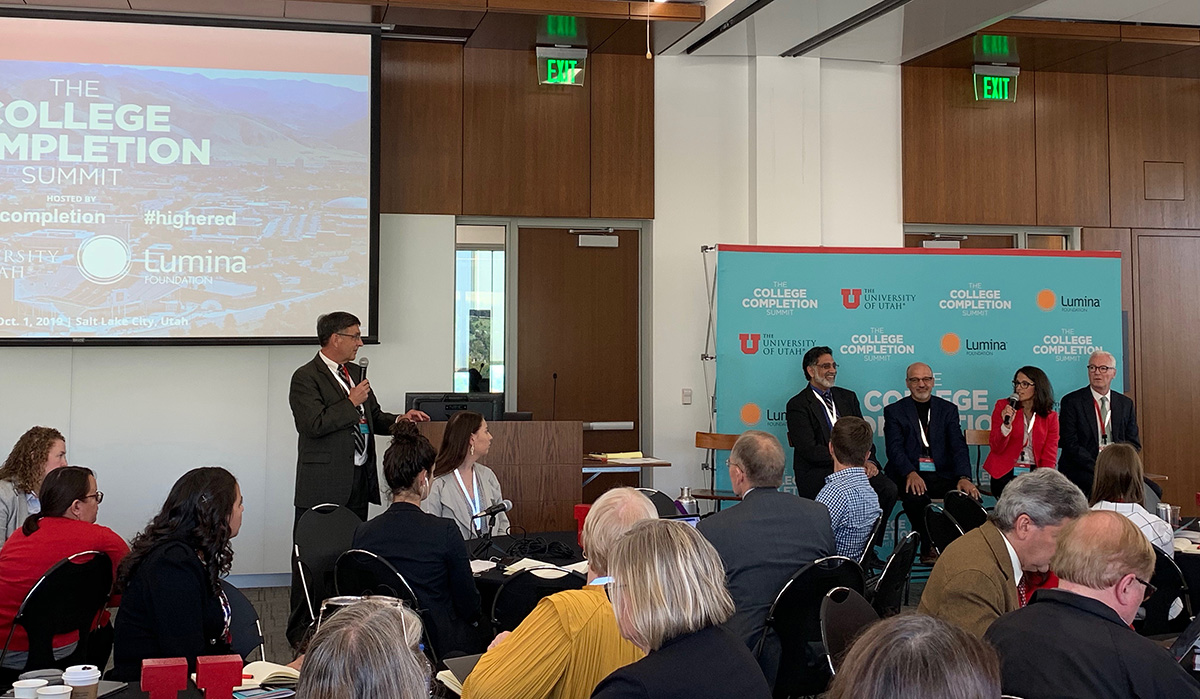Editor’s note: This is one in a series of stories about The College Completion Summit held at the University of Utah on Sept. 30-Oct. 1, 2019. Vistasp M. Karbhari, president of the University of Texas at Arlington, gave a keynote address. A panel followed on “Data and Technology Contributions to Completion.” Panel members included: Paul Dosal, vice president for Student Affairs & Student Success at the University of South Florida; Frederick Corey, vice provost for Undergraduate Education at Arizona State University; and Rachelle Germana, associate provost for Academic Success at Stony Brook University. The moderator was Frank Dooley, senior vice provost for Teaching and Learning at Purdue University.
Data can be revealing, even predictive, and technology can keep students plugged into online lectures at two in the morning. But it’s still human interaction that makes the difference between students dropping out or staying in school.
That was one takeaway from the panel “Data and Technology Contributions to Completion” at the recent College Completion Summit sponsored by the University of Utah and Lumina Foundation.
“If we automate everything, we will fail,” cautioned keynote speaker Vistasp Karbhari, president of the University of Texas at Arlington, where 17,000 students are getting degrees online and a significant number of undergraduates are over the age of 30. “At the end of the day, we need the human touch.”
“We expect that once we have the data it’s going to give us one solution that looks across the entire population,” he added. “What we forget is that predictive analytics tells us why something might not be happening. It doesn’t automatically tell us what we should be doing.”
At Arizona State University, a “cultural transformation” in 2007 helped the school organize around the student, “rather than the faculty or the university itself,” noted Fred Corey, vice provost for undergraduate education. And this is where technology was a helpful partner. Through an “E-Advisor” suite of tools, students at ASU can, for example, map out the progress they’re making toward their degree, discover if they’re off-track, then change direction. “This saves the face time for other pressing issues, like ‘what am I doing here?’ or ‘I feel like I’m lost in the world.’”
“It’s really a combination of high tech and high touch,” said Stony Brook University’s Rachelle Germana, associate provost for academic success. The school’s Academic Success Team meets weekly, going through 10,000 bagels in the past eight years as they’ve wrestled with how to use increasing mounds of data in the service of its students. One strategy: A year-out scheduling model so students can plan their classes better. Stony Brook has increased its graduation rate by 17% in the past six years.
At the University of South Florida, the school’s Persistence Committee uses both data and a case management approach, said Paul Dosal, vice president for student affairs and student success. And this has led to relying not just on academic advisors, but teachers and residence hall advisors. “The reality is, we have hundreds of people on our campuses who are trained, and have the passion, to work with students.”
Universities have long used data to decide whom to admit, trying to determine who will likely succeed, admitting those students and rejecting the rest. But panel moderator Frank Dooley, senior vice provost for teaching and learning at Purdue University, suggested a different approach. “I think that our collective mission is to resist that trend. . . . To use the data—not to decide who to exclude, but who to include and how we’re going to help those individual students succeed.”
